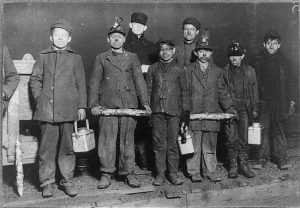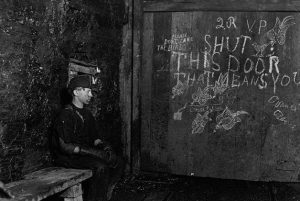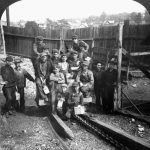
 Most of us have heard, either from our dads, grandfathers. or great grandfathers about how they or their ancestors had to quit school at an early age to work and help support the family. Life at the turn of the 20th Century was not easy. With the great depression, and poverty everywhere, and no real child labor laws, and the Industrial Revolution in full swing, the kids had little choice but to go out and help their families put food on the table. At that time in history, there were no real child labor laws in place, and there was a need that had to be filled. Whole families were in danger of starvation. The family had to get some money soon. Exceptions were made.
Most of us have heard, either from our dads, grandfathers. or great grandfathers about how they or their ancestors had to quit school at an early age to work and help support the family. Life at the turn of the 20th Century was not easy. With the great depression, and poverty everywhere, and no real child labor laws, and the Industrial Revolution in full swing, the kids had little choice but to go out and help their families put food on the table. At that time in history, there were no real child labor laws in place, and there was a need that had to be filled. Whole families were in danger of starvation. The family had to get some money soon. Exceptions were made.
Because of the circumstances of the times, and the need to eat, the nation’s children went to work. They worked in coal mines, factories, agriculture, and every other menial job they could get. So many of these jobs would have detrimental affects on the health of the workers. It was not unusual to find whole families or father-son pairs who were hired together. Unfortunately, children were not given jobs that suited their status as young, impressionable people who aren’t able to really care for themselves, much less do a skilled job. The child laborers were often given the jobs adults physically couldn’t accomplish. That sounds strange to us, but it meant crawling into tiny places the adults could not fit through. As an example, in factories, children were sent into the tiny, cramped interiors of the machines. Their task was to fix mechanisms that the adults simply couldn’t reach. This was dangerous work, and even with doing things the adults couldn’t, children received lower pay than the adults who depended on them.
The small stature of the children ensured that they often had the most dangerous jobs available in the coal mines too. As greasers, the children were constantly in danger of being crushed by carts loaded down with coal, as they ran up and down the tram tracks, a heavy bucket of grease on each arm, making sure the tram axels were appropriately greased at all times. Nippers (also called trappers) were children who had the dangerous responsibility of opening and closing the shaft doors as coal cars came hurtling down the sloped tracks. Boys who fell asleep in the total stillness and darkness…sometimes a mile beneath the surface…would be crushed if they failed to lift the door.
Eventually, activists began to take issue with the treatment of children in positions like these. One photographer…Lewis Hine made it his personal mission to document the situation of children in the coal fields of 
 Appalachia. Because of his persistence, we have a cache of images documenting this era of American child labor. These and many other images led the US government to pass the Keating-Owens Child Labor Act of 1916. The act created a minimum age of 16 for mine workers, as well as instating the eight-hour workday. Then, shockingly, this act was deemed unconstitutional. The child labor issues continued until the 1930s, when the New Deal brought permanent reform for child laborers.
Appalachia. Because of his persistence, we have a cache of images documenting this era of American child labor. These and many other images led the US government to pass the Keating-Owens Child Labor Act of 1916. The act created a minimum age of 16 for mine workers, as well as instating the eight-hour workday. Then, shockingly, this act was deemed unconstitutional. The child labor issues continued until the 1930s, when the New Deal brought permanent reform for child laborers.


Leave a Reply